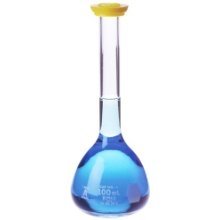|
There are accepted ways to communicate the degree of accuracy to which measurements have been taken and one of these is to record the raw data along with its limits of uncertainty by means of a ± sign. |
|
Inaccuracy limits
The accepted method for recording inaccuracy is to use the plus/minus sign,
±, to indicate the possible range of uncertainty of the reading shown.
This may be expressed as a percentage of the whole measurement.
The sign means that there is an equal possibility of the reading having either a higher limit or a lower limit. Certain instruments and pieces of apparatus have the inaccuracy range, also called the tolerance, written on the apparatus, along with the conditions under which the inaccuracy has been determined.
For example: A grade B 250 ml volumetric flask may have the following legend.
| 250 ml ± 0.30ml @ 20ºC. |
This means that when the apparatus is used exactly in the correct way, there is still an uncertainty of plus 0.30 ml to minus 0.30 ml in the actual volume of solution contained. In other words the actual volume of the solution could be anywhere between 250.30 and 249.70 ml.
Recording Inaccuracy
When recording raw data it is important to also record the degree of accuracy of the measurements taken.
If a standard piece of apparatus is used it may have the inaccuracy written on it. However, in many cases a value judgement must be applied to give a reasonable assessment of the degree of accuracy involved.
A simple rule of thumb is to say use the idea that we are able to read a measurement to within half of the value of the smallest graduation of a visual measuring instrument, such as a ruler, burette or measuring cylinder.
We must also remember that if the difference between two readings is being used then effectively two readings are taken and the overall inaccuracy is doubled. This is the case in measuring volumes of liquid delivered by a burette.
|
For example: In a titration the following measurements were taken.
This expresses the data point as having a maximum possible value of 17.35 ml and a minimum value of 17.15 ml. |

